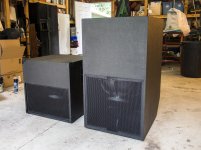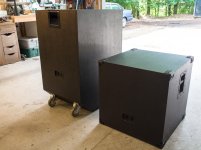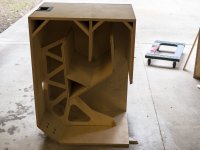Brian those are the PAL12's.
Interesting. Do you notice any sort of cancellation issues when playing them with the other subwoofers pictured?
The mids are sealed back midranges. So no need for a large cabinet behind them.
The midbass were made super compact to fit in my old car. I may rebuild in the future to larger ported enclosures
And I haven't tried this comp driver on other waveguides. But I do enjoy the sound on this one!
The midbass were made super compact to fit in my old car. I may rebuild in the future to larger ported enclosures
And I haven't tried this comp driver on other waveguides. But I do enjoy the sound on this one!
I didn't get a chance to run any sweeps with the mic. By the time I set it all up and quickly set the Filters in the driverack it was getting cloudy I really need some time with it and in a different area so I don't **** off the neighbors lol
So I didn't check for cancelation with the subs
So I didn't check for cancelation with the subs
Interesting. Do you notice any sort of cancellation issues when playing them with the other subwoofers pictured?
When I posted about the phase differences causing cancelation a while back Art seemed confident that it wouldn't be a huge issue. It's not ideal but I had built the PAL's then got the TH-18's back so instead of wasting I figured I'd use them together.
When I posted about the phase differences causing cancelation a while back Art seemed confident that it wouldn't be a huge issue. It's not ideal but I had built the PAL's then got the TH-18's back so instead of wasting I figured I'd use them together.
I don't know if I'd agree with Art on that, but then again he's in the PA business - I'm not
I'd be strongly tempted to measure their performance together however, even if it's a 1M measurement at low volume. Basically measure one on it's own, then connect the other, while leaving everything else the same, and repeating the measurement.
Oh, and the following link may be of interest re setting up subwoofers. I like the ICAD array - simple to do and the theory behind it seems pretty sound:
Live Sound: The “Power Alley” - Discussion & Solutions To The Troubling Interaction Of Subwoofers - Pro Sound Web
The Xoc1 TH-18 and Pal 12 both have similar phase and frequency response, so will "play well" with each other, but use different drivers, so would best use amplification and limiting appropriate for their power ratings.I don't know if I'd agree with Art on that, but then again he's in the PA business - I'm not
The DSL TH-118, TH-115, and Keystone sub also all have similar phase and frequency response, so also can be "mixed and matched" using amplification, limiting, and EQ appropriate for the drivers used.
Art
Finished my builds over the weekend (the smaller box is a Cubo 15). 
This was actually my first substantial woodworking project (I had some coaching from my dad-in-law), and I learned a ton. Using a Wixey digital protractor for the weird angled cuts was a lifesaver -- all of the pieces ended up fitting together amazingly well.
This was actually my first substantial woodworking project (I had some coaching from my dad-in-law), and I learned a ton. Using a Wixey digital protractor for the weird angled cuts was a lifesaver -- all of the pieces ended up fitting together amazingly well.
Attachments
My first REW measurements
I finally managed to get some initial measurements done, but be aware that the results comes with a solid disclaimer since I am a true novice with REW and measurements in general.
Having said that, I hope you will comment on these initial results.
My setup:
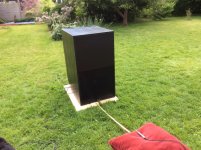
Measurements takent of my first three built TH-18. The first built got a little of, which maybe explains the difference in the output.
Mike is a DBXRTA with a calibration file I found via google and running thru a calibrated external soundcard. Output from the soundcard feeded into a mixer and via DBX PA into the amps:
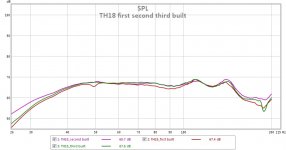
I measured my old CAD118 18" subs and compared with the TH18 here:
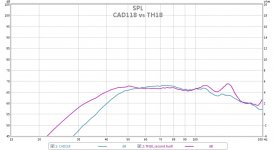
I wonder why the output is not higher on the TH18 compared to the old ported subs, but maybe the type of measurement will not show that?
And the TH18 is with cone correction from Djim
I still need to make some comparing with different conecorrection and Xmax.
Best, Andy
I finally managed to get some initial measurements done, but be aware that the results comes with a solid disclaimer since I am a true novice with REW and measurements in general.
Having said that, I hope you will comment on these initial results.
My setup:

Measurements takent of my first three built TH-18. The first built got a little of, which maybe explains the difference in the output.
Mike is a DBXRTA with a calibration file I found via google and running thru a calibrated external soundcard. Output from the soundcard feeded into a mixer and via DBX PA into the amps:

I measured my old CAD118 18" subs and compared with the TH18 here:

I wonder why the output is not higher on the TH18 compared to the old ported subs, but maybe the type of measurement will not show that?
And the TH18 is with cone correction from Djim
I still need to make some comparing with different conecorrection and Xmax.
Best, Andy
Hi Martin,
Haha.. I didn't think it would make a difference with those frequencies.
I have not yet found a suitable SPL meter to go with REW and therefore the measurements I did was purely for frequency. I was hoping to get phase, but it didn't come out right.
If anyone can recommend a SPL meter for REW, here in Europe please come forward.
I made another set of measurements with a top (15+2) 4 meters and the mic on a stand appr. 1.5 m above ground. The sub is too loud and I am working hard to find out why I have a dip in 1khz.
The scenery :0)
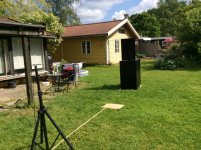
The setup is Low= Highpass 30hz/24db Lowpass 100hz/12db. Mid=Highpass 100hz/12db Lowpass 1.4kz/24db. High = Highpass 1.4kz/24db. No EQ.
The REW graph:
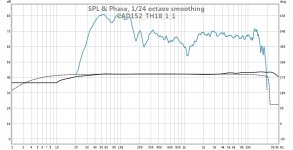
Regards, Andy
Haha.. I didn't think it would make a difference with those frequencies.
I have not yet found a suitable SPL meter to go with REW and therefore the measurements I did was purely for frequency. I was hoping to get phase, but it didn't come out right.
If anyone can recommend a SPL meter for REW, here in Europe please come forward.
I made another set of measurements with a top (15+2) 4 meters and the mic on a stand appr. 1.5 m above ground. The sub is too loud and I am working hard to find out why I have a dip in 1khz.
The scenery :0)

The setup is Low= Highpass 30hz/24db Lowpass 100hz/12db. Mid=Highpass 100hz/12db Lowpass 1.4kz/24db. High = Highpass 1.4kz/24db. No EQ.
The REW graph:

Regards, Andy
- Home
- Loudspeakers
- Subwoofers
- TH-18 Flat to 35hz! (Xoc1's design)
